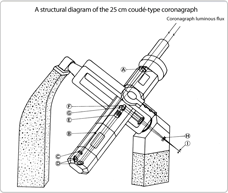The Norikura Solar Observatory of the National Astronomical Observatory of Japan, located in the Norikura mountain range in Nagano Prefecture, was once the only facility in Japan from which the Sun's corona could be observed. The coronagraph, which was installed there in 1950, was built by Nikon (then named Nippon Kogaku K.K.).
Japan's first coronagraph

The corona observed by the 10 cm coronagraph
The corona is the name given to the atmosphere that surrounds the Sun. The corona is always there, but because its brightness is only 1 millionth that of the Sun, it is not normally discernable. The corona can be seen with the naked eye only during a total solar eclipse, and yet observation of the corona is essential to research of solar activity. To make such observations possible, it is necessary to reproduce the effects of a total eclipse, and that is exactly what the coronagraph does. The first corona observation using an artificial eclipse was made in 1930 using a coronagraph established on the French side of the Pyrenees Mountains. In 1942, the Tokyo Astronomical Observatory (now the National Astronomical Observatory of Japan) asked Nikon to build a prototype of an objective lens for use in a coronagraph; however this project never came to fruition.

The 10 cm coronagraph
Then, in 1947, the National Astronomical Observatory of Japan built a coronagraph prototype and Nikon was asked to produce the objective lens and all optical components. After conducting test observations at numerous sites, it was decided to make Norikura the permanent home of the new coronagraph. Based on the strength of Nikon's performance producing parts for the prototype, Nikon was then entrusted with the construction of Japan's first 10 cm coronagraph.
Completion of the coronagraph
A coronagraph is a special astronomical telescope that imitates the effects of the moon by placing an occulting disk at the focal position of the Sun's image to block it out, thus creating a pseudo-eclipse and enabling observation of the faint rays of the corona. It is also equipped with a prism to enable detailed observation of the corona.
The objective lens is subjected to the intense rays of the Sun, and so reflected light from the surface of the lens as well as light scattered by scratches, internal bubbles and striations are easily generated. This scattered light prevents the observation of the faint corona. Preventing this phenomenon requires use of a single lens made from high-grade optical glass that resists air bubbles and striations.
Through trial and error, Nikon successfully smelted a glass that met these specifications and produced an optical glass considered to be of the highest quality in the world at that time. Even the minute imperfections tolerable in the average photographic lens are a major hindrance in a coronagraph. Thus, great care was required in the polishing process to create a lens with absolutely no scratches.
A variety of measures was taken to control scatterings, such as the application of an anti-reflection coating to the inside of the coronagraph and the installation of an aperture in the lens barrel. A special occulting barrel was also used to absorb reflections from the occulting disk, and a cooling system was installed to circulate coolant that prevents fluctuations in the air caused by the high temperature generated by the Sun's heat on the occulting disk.
The objective lens is subjected to the intense rays of the Sun, and so reflected light from the surface of the lens as well as light scattered by scratches, internal bubbles and striations are easily generated. This scattered light prevents the observation of the faint corona. Preventing this phenomenon requires use of a single lens made from high-grade optical glass that resists air bubbles and striations.
The hard work paid off, however, and the Norikura Solar Observatory was opened in 1949, and in the following year, the 10 cm coronagraph was completed. At the time, this 10 cm coronagraph was only one of six of its kind in the world. It also served an important role because the geographical location allowed observations to be made when it was nighttime in Europe and the United States.
In 1971, Nikon completed the 25 cm coudé-type* coronagraph, the third largest of its kind in the world at that time. The objective lenses used were the largest ever made in Japan and of the highest quality at that time.
- *Coudé-type:
A type of telescope that maintains its focus when pointed in any direction.

The Norikura Solar Observatory
The 10 cm coronagraph is housed in the dome on the left, while the 25 cm coudé-type coronagraph is housed in the dome on the right.

The 25 cm coudé-type coronagraph
A new way of observing the corona
The mechanism that generates the corona is still not understood today. Using a prism with the 10 cm coronagraph to measure the brightness of 72 points around the Sun each day for several decades, we have learned that the brightness of the corona changes on an 11-year cycle. Several types of prism were used on the 25 cm coudé-type coronagraph that led to many new discoveries, such as the corona's complex temperature structure, and enabled the observation of changes in the corona's structure after explosions known as flares. This data is a great asset to solar research in Japan and around the world.
In March 2010, exactly 60 years after the completion of the 10 cm coronagraph, the Norikura Solar Observatory closed due to the aging of the equipment and facilities. Corona observations are now being made by the Hinode solar observation satellite launched in September 2006. X-ray telescopes are now the primary method of observing the Sun's entire corona, but because the atmosphere absorbs x-rays, corona observations are made from outer space.
However, some researchers believe there is information that can only be measured from Earth. One day, the terrestrial, large-diameter coronagraph may make a comeback.


